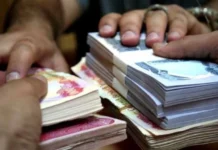Good Morning ,
HOW US TRADE WARS ARE SHAPING THE CRYPTO MARKET
Trump’s trade war tariffs triggered volatility in crypto markets, with Bitcoin dropping to $91,200 before rebounding. While short-term turbulence persists, rising inflation could drive long-term crypto adoption as a hedge against devaluation. Investors should stay vigilant.
Over the past month, the crypto market has experienced notable price swings, with the total market capitalization oscillating between $3 trillion and $3.73 trillion. A key catalyst behind this volatility is President Trump. While his inauguration took Bitcoin to a new all-time high of $109,200, his recent trade war did the opposite.
The administration imposed a 25% tariff on imports from Canada and Mexico, along with a 10% tariff on Chinese goods, sending shockwaves through global markets including the crypto sector.
Although a temporary 30-day pause on these tariffs provided some relief, taking Bitcoin over the $100k mark, subsequent actions such as an additional 25% tariff on iron and aluminium left investors with a big question — How are these tariffs going to affect the crypto market?
The Reason Behind the Tariffs
The primary stated reason for these tariffs was to curb illegal immigration and prevent the inflow of contraband. However, many interpret this move as a strategic signal of US dominance over major economies.
Although Canada and Mexico quickly pledged to deploy around 10,000 personnel each to secure their borders—a move that led to a temporary pause in further tariff increases—the subsequent 25% tariff on iron and aluminium reveals a deeper strategic intent from the US.
This additional tariff indicates that the US is determined to maintain pressure on key industrial sectors, suggesting that the trade war is far from over.
How Did the Markets React?
The crypto markets had a knee-jerk reaction to the news taking Bitcoin to a low of $91,200. However, the market’s resilience soon became evident when Bitcoin rebounded by over 10% in a single day, soaring to $102,000, and eventually stabilizing around $97,000. Similarly, altcoins experienced profit booking taking the market cap down to $3.4 trillion by the time the pause was announced.
The tariffs increased inflation fears and concerns over upcoming Federal Reserve rate decisions shifted investor sentiment. But a zoomed-out look at the markets would have helped investors see the hidden benefits of the trade war.
Long-Term Implications of the Tariff War
While the tariff-induced volatility has caused short-term corrections, there are long-term dynamics at play that could ultimately benefit the crypto sector. When a country increases tariffs, it often leads to higher inflation.
The US, for instance, imports billions of dollars worth of construction materials from neighbouring countries. Increased tariffs on these essentials drive up costs, potentially fueling inflation and weakening the dollar. In such scenarios, safe-haven assets like gold and crypto—tend to gain traction as investors seek protection against devaluation.
The recent CPI data showing a 0.5% increase in inflation is an early sign of the tariff war. Should the tariff war continue, it could create a macroeconomic environment where digital assets serve as an effective hedge against inflation. Coupled with improving regulatory clarity and growing institutional interest, this scenario may spur broader adoption of crypto over the long term.
Conclusion
The short-term turbulence triggered by Trump’s trade war offers a dual advantage for the crypto market. Firstly, it creates attractive entry points for investors, and secondly, it establishes a favourable environment for long-term sector growth.
While these conditions position Bitcoin and other digital assets on an upward trajectory, investors must remain vigilant and monitor trade developments closely to navigate news-driven volatility. Focusing on capital preservation and maintaining disciplined investment strategies will be key to capitalizing on future growth opportunities.
@ Newshounds News™
Source: Economic Times
~~~~~~~~~
BRICS DISCUSSES ALTERNATIVE PAYMENT PLATFORMS TO BYPASS WESTERN FINANCIAL SYSTEMS
BRICS Advances Alternative Payment Systems to Reduce Western Dependence
BRICS nations are actively discussing the development of alternative payment platforms to reduce their dependence on American financial systems, Tass reported on Feb. 19, citing Russian Foreign Minister Sergey Lavrov. Addressing the Russian State Duma, Lavrov emphasized that the initiative was originally pushed by Brazilian President Luiz Inácio Lula da Silva.
“This is being discussed in BRICS, at the initiative of [Brazilian President Luiz Inacio] Lula da Silva … The previous summit stated a decision on the necessity of developing a proposal on alternative payment platforms through finance ministries and central banks,” he detailed, elaborating:
Such proposals have been made, they suggest, in particular, the creation of a so-called transborder payment initiative, the creation of a reinsurance company, and the BRICS Clear settlement and depositary infrastructure.
The proposal aims to provide member states with greater financial sovereignty through independent transaction mechanisms.
The 16th BRICS Summit, held in Kazan from Oct. 22-24, 2024, marked a major milestone under Russia’s chairmanship. It was the first summit to include newly admitted members.
During the event, BRICS leaders formalized their commitment to alternative payment solutions through the adoption of the Kazan Declaration.
The declaration outlined key financial goals, including “the possibility of establishment of an independent cross-border settlement and depositary infrastructure, BRICS Clear, while member states’ finance ministers and central bank chiefs were tasked with properly continuing the consideration of the issue of using national currencies, payment instruments and platforms.” The move signals a collective effort to establish a financial system less reliant on Western institutions.
BRICS nations have been actively working to reduce their reliance on the U.S. dollar in global trade and financial transactions. Many member states have increasingly turned to local currencies in trade agreements, aiming to bypass Western-dominated financial systems.
The push for alternative payment platforms, such as BRICS Clear and a trans-border payment initiative, is distinct from discussions about a single BRICS currency.
While the payment platforms focus on enabling cross-border transactions using existing national currencies, the single currency initiative—still in early discussions—would require deeper financial integration and a shared monetary framework. Unlike a common currency, which demands extensive policy coordination, independent payment platforms allow BRICS nations to strengthen economic cooperation while maintaining control over their domestic monetary policies.
@ Newshounds News™
Source: Bitcoin News
~~~~~~~~~
Seeds of Wisdom Team RV Currency Facts Youtube and Rumble
Newshound’s Podcast Link
Newshound’s News Telegram Room Link
Q & A Classroom Link
Follow the Roadmap
Follow the Timeline
Seeds of Wisdom Team™ Website
Subscribe to Seeds of Wisdom Team™ Newsletter





